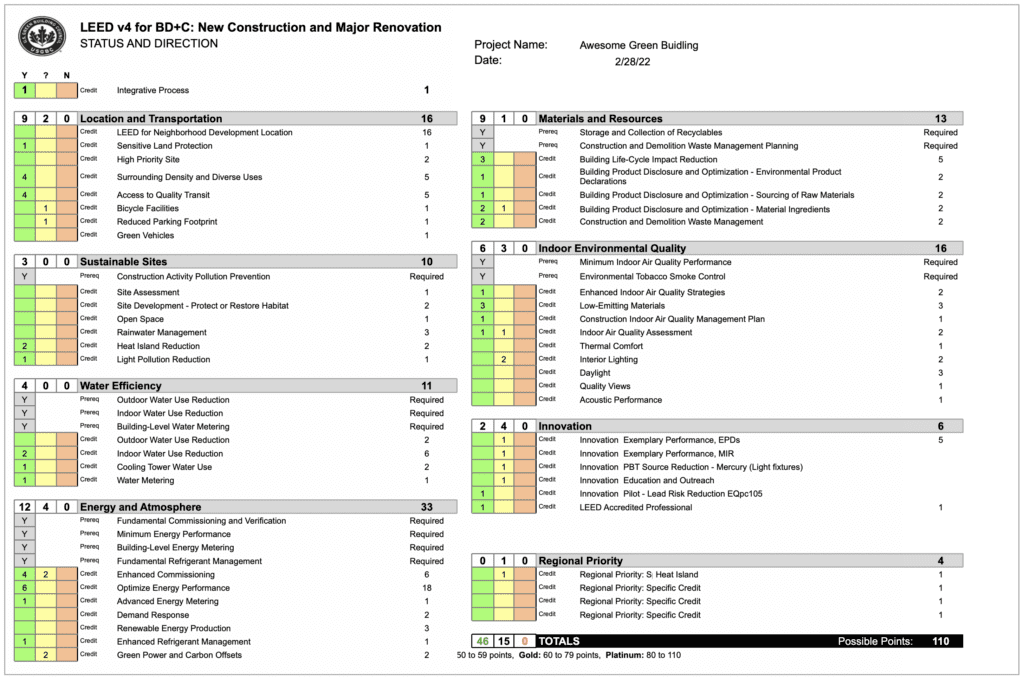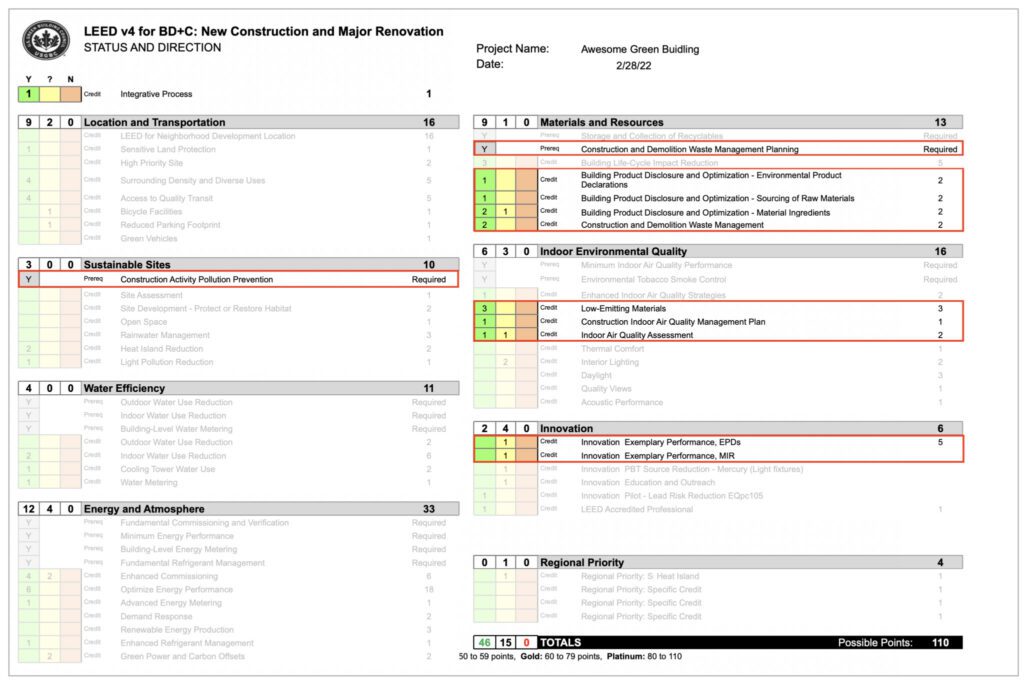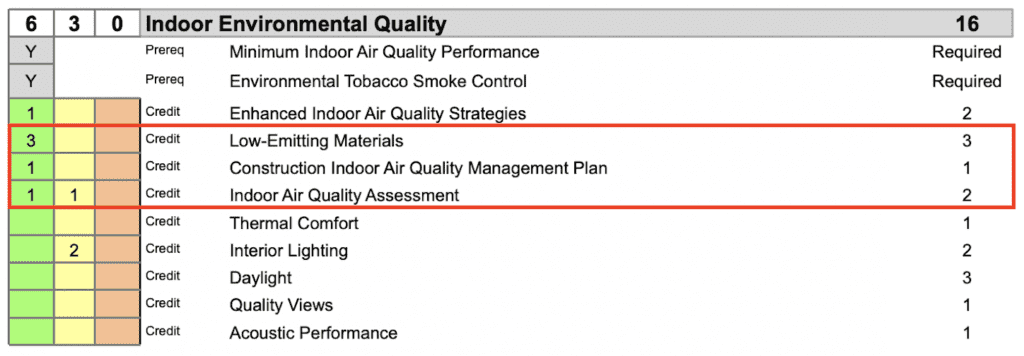Surprisingly enough, no one is born learning how to read a LEED scorecard. If you’re working on your first LEED project and need some guidance on how to read a LEED scorecard, Green Badger has you covered.
LEED (acronym for “Leadership in Energy and Environmental Design”) is one of the most widely used green building rating systems in the world. LEED offers a holistic framework to help design-build teams create healthier and more efficient buildings.
The various aspects or “credits” considered by the LEED system are organized by credit category in a LEED Scorecard. There are different scorecards depending on the type of building to evaluate. These include new construction, core and shell, schools, retail, data centers, warehouses and distribution centers, hospitality and healthcare. Each scorecards considers 110 “possible points”, grouped in 8 categories.

When a building earns 40 to 49 points by this system, it can be “LEED certified”. Silver certification is for 50 to 59 points, Gold for 60 to 79 points and the LEED Platinum seal is earned if the team achieves 80 to 110 points.
The LEED scorecards can be used as guide, helping the design-build team make decisions throughout the phases of design and building.
LEED credits are also broken down into design and construction credits.
Green Badger software tracks the construction credits, which must be overseen throughout the entire construction phase from setting up the job trailer to Indoor Air testing after construction. This process can take months if not years to complete.

The owner and architect work together to determine which points they can realistically earn based on the type of project. Once they have their targets, the architect and contractor will use this as a live excel document and move points into appropriate categories as the construction progresses, showing points to be earned tallied at the bottom of the scorecard. If the architect and GC keep the LEED scorecard live in excel, rather than saving in pdf format, it is possible to show which credit point are earned, expected to be earned, and not expected to be earned, allowing the team to strategize during the course of construction.
Below is a typical LEED Scorecard:

A “Y” entered into a cell indicates the credit is a prerequisite. This means the project has no choice but to earn that particular credit. If there is a number in the first column, in this case the green column, the owner expects the construction company to achieve the credit. If there is a number in the second column, in this case the yellow column, it means the owner would like the construction company to achieve the credit, but based on the job mix, they understand that it might not be possible. If there is a number in the third column, in this case the orange column, the owner does not expect the contractor to achieve the credit. Scorecards can run 4 columns, but the farther you move to the right, the less likely the credit point is expected to be earned.
Here is the same LEED scorecard with the construction credits (highlighted) that general contractors are contractually obligated to earn based on what level of LEED certification the project is going for.


Sustainable Sites
The construction credit under Sustainable Sites is the Prerequisite Construction Activity Pollution Prevention (also known as SSp1, Erosion Control, and SWPPP). The goal is to ensure dirt from your site stays on the site and doesn’t get into waterways/sewers and does not fly off in the breeze. The civil engineer will have a plan that meets the EPA GCP or the local standard, stands for General Construction Permit, whichever is more stringent. The GC is responsible for implementing the plan.
For Green Badger’s recommendations are strategies to earn the Construction Activity Pollution Prevention prerequisite credit, read our Ultimate Guide to LEEDv4/v4.1 Construction.

Materials and Resources
GCs must oversee and implement the three BPDO (Building Product Disclosure and Optimization) credits and Construction and Demolition Waste Management under Materials and Resources section.
EPDs (Environmental Product Declarations) – the owner will either request 1 point or 2 points (Multi-attribute optimization).
For Green Badger’s recommendations are strategies to earn the Environmental Product Declarations credit, read our Ultimate Guide to LEEDv4/v4.1 Construction.
Sourcing of Raw Materials refers to responsible sourcing. If 15% of the cost of the total value of permanently installed products are responsibly sourced/ extracted, the team earns 1 point. If 30% of the cost of the total value of products are responsibly sourced/extracted, the team earns 2 points for this credit. Recycled content is the most common way to earn toward this credit, but biobased products, FSC wood, material reuse and extended producer responsibility (take back programs) also count with proper documentation.
For Green Badger’s recommendations are strategies to earn the Sourcing of Raw Materials credit, read our Ultimate Guide to LEEDv4/v4.1 Construction.
Material Ingredient Reporting – products that have Health Product Declarations, Cradle to Cradle or Declare labels help teams earn this category.
If the first column is checked 1, the owner expects the GC to earn 1 point for this credit. A second 1 indicates a requirement/request to earn a second point (Material Ingredient Optimization).
For Green Badger’s recommendations are strategies to earn the Material Ingredient Reporting credit, read our Ultimate Guide to LEEDv4/v4.1 Construction.
Construction Waste Management – LEED project teams can achieve 2 points for construction waste management with proper planning and communication. However, all projects must first develop and implement a construction and demolition waste management plan to achieve any points. For more information, check out our blog post on How to Create a Construction Waste Management Plan for LEED.

Indoor Environmental Quality
In addition to a prerequisite for Minimum Indoor Air Quality Performance, owners will indicate the number of points they want the team to earn for Low Emitting Materials. A target of 3 points is typical request, indicating 4 compliant categories. There are 8 in total to choose from (adhesives & sealants, paints & Coatings, flooring, walls, ceilings, insulation, furniture, and composite wood).
Low Emitting Materials
Points for low-emitting materials
2 product categories – 1 point
3 product categories – 2 points
4 product categories – 3 points
5 product categories – 3 points + exemplary performance
Reach 90% threshold in at least three product categories Exemplary performance or 1 additional point if only 1 or 2 points achieved above.
For Green Badger’s recommendations are strategies to earn the Low Emitting Materials credit, read our Ultimate Guide to LEEDv4/v4.1 Construction.

Innovation Credits
A maximum of two construction credit exemplary performance points may be contributed toward the Innovation Credit, even if the GC earns more. Construction Teams can earn the following exemplary performance credits:
- EPDs (by earning 20 products rather than 10 for Interior Design & Construction and Core and Shell projects) OR
- EPDs (by earning 40 products rather than 20 for New Construction projects)
- Material Ingredient Reporting (by earning 20 products rather than 10 for Interior Design & Construction and Core and Shell projects) OR
- Material Ingredient Reporting (by earning 40 products rather than 20 for New Construction projects)
- Low Emitting Materials, by being 90% compliant or more in 3 or more product categories.
The innovation credit is not a contractual obligation, just an opportunity to toss the exemplary performance credits toward the Innovation Credit (max 2 points from construction allowed).
For more detailed information on how Green Badger recommends you going about earning these LEED construction credits, read our Ultimate Guide to LEED v4/v4.1 Construction!




